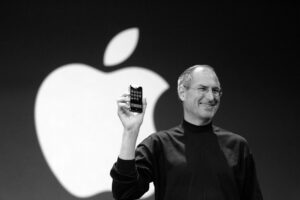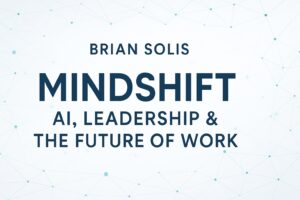
A key objective for senior executives over the next several years is to use disruptive technology to get closer to customers, to improve relationships, and enhance experiences. It is a considerable move and the result will usher in a new era of adaptive and empathetic business models. However, this is a move that is easier said than done., especially when vision and execution are two sides of different coins. This is a critical path where businesses must not only commit to new technology and goals, but also invest in the methodologies, systems, processes, and people to bring about change from within before it can effectively engage outside.
Like in anything, businesses are measured by actions and words, where outcomes reveal true progress. In 2012 and 2013, businesses will prioritize efforts that bring the organization closer to customers while also performing against the metrics that are constant, including revenue, market share, increased efficiencies and improved margins. The difference now is that today’s company faces a formidable customer that is connected, empowered, influential, and most notably elusive. To earn their attention, their business and ultimately their loyalty and advocacy, the customer journey must be reconsidered, redesigned and individualized.
In a survey of over 1,700 CMOs in 2011, IBM found that the intention of customer engagement was certainly present, but that executives were unclear in how to assess and integrate new technology in managing and leading customer relationships. Of the 13 key market factors below, an alarming 50+ percent of respondents are under prepared to manage all but two key changes, Regulatory Considerations and Corporate Transparency.

Certainly, the model for tomorrow’s business is under development today. What’s clear is that the answers to lead change and chart new directions are unclear. And, this represents both a challenge and opportunity. Determined businesses will not sit idly while the market is defined by new technology and corresponding customer behavior. Nor will enterprising businesses adopt every new trend that comes along as a way of surfing waves of short-term relevance. Leaders and change agents will develop a process and taskforce to assess new technology against corporate vision, customer expectations, and market direction to prioritize investments in the following areas:
1. Integrated strategy and execution toward business objectives
2. Renewed, unified and consistent branding
3. Organizational structure, alignment and the empowerment people
4. Operations and supply chain
5. Improved processes
6. Collaboration
7. Customer service and engagement in new channels
8. Risk and reputation management
9. Integrated experiences – Mobile/Tablet/Digital/Social
10. Syndicated commerce
11. Metrics and value systems
These areas of focus represent the trends in transformation as expressed through the aspirations of executives who hope to get closer to customers and the expectations of the customers they hope to reach. This is as much about technology and vision as it is about reducing friction, inside and out. In the end, the convergence of disruptive technology, business processes, and customer experiences forces any organization to examine and re-examine everything. Every effort today carries opportunities for optimization or complete overhaul. The end result is increased relevance, improved experiences, and escalated results.
Some of the key areas of focus for any business in this convergence will include:
1. Big data and the necessary algorithms to make sense out of sheer volume and noise – the net result is intelligence to set the foundation for Adaptive and Predictive business models
2. Social and mobile media as it relates to customer influence, the customer journey, and post-commerce activities
3. Contact centers and the unification of democratized channels such as Facebook, Twitter and Google+ and a managed customer relationship system
4. Metrics, ROI, and meaningful outcomes that look beyond today’s limited KPIs that focus on friends, fans, followers, views, etc.
5. The relationship between CMO and CIO and how together, they will need to invest in innovation and scalability for a new breed of employee, consumer, and an unending array of emerging and disruptive technology
While these reflect only part of the trends requiring transformation, they collectively contribute to customer and employee preference and ultimately competitive advantage. This is the year when we must take a step back to cut through the fog of hype and identify the gaps between business objectives, customer expectations,the important technology channels that separate businesses and customers, and the capabilities and prowess to effectively engage and lead experiences across the board.
In further reviewing the IBM CMO Global Study, CMOs are prioritizing new technology investments as it relates to increasing engagement and improving customer relationships and experiences.

As you can see above, the examination of disruptive technology and the exploration of revising internal processes are aligning to…
1. Enhance customer loyalty/advocacy
2. Design experiences for tablet/mobile apps
3. Use social media to engage customers…their way
4. Use integrated software to better manage customer relationships
5. Listen and learn
This list should be viewed as a checklist for leading important conversations that contribute to a strategy roadmap. Where businesses are and where they will be next year and five years from now will not be predicated simply by social media. Customer expectations and the capacity to translate trends into actionable market opportunities requires a syndicated, but integrated approach, one where all channels are considered and weighted based on behavior and educated predictions. The true opportunity for customer engagement and scalable profitability lies in the architecture of not only a more social business, but a holistic enterprise that operates under a united front. But to get there requires the difficult first step, acceptance. Second, businesses need to assemble capable stakeholders who can organize the necessary treatise between social media champions, change agents, and leaders to organize a distributed movement that empowers employees, engages customers optimizes experiences, and adapts to new opportunities for growth and earned relevance.
Connect with me: Twitter | LinkedIn | Facebook | Google+ |
Order The End of Business as Usual today…
Image Credit: Shutterstock






Brian again you hit the nail on the head. Wondering can CMO’s still be thinking this is all to far ahead on the horizon when customers are now more connected and savvy than their brand?
Talk about flipping the script on businesses. 2012 wil be interesting to watch unfold and see who will position themselves so they are still a part of the game, instead of watching on the side lines.
Great to see loyalty and advocacy bubble up. Seems that CMOs may be moving away from the myth that social media creates new customers out of thin air. The goal of social – in almost every case – should be to turn customers into volunteer marketers.
Or to improve relationships and experiences which can also lead in that direction… 😉
Right. One begets the other.
Improving existing relationships and experiences with current customers is what’s bringing me back to social. Feels good!
@doolin:disqus in the house! Hey friend, just saying hi – you caught my eye. 🙂 So love that it was via Brian’s blog that I got to feature you in my book. hehee
YES! 🙂 *improve relationships and experiences that leads to raving brand evangelists a.k.a volunteer marketers* as @jasonbaer:disqus calls them. hehee. Amazing post, Brian, as always. I just love the way your mind works. I’d like to borrow some of your neural pathways, please. Lol.
LOL!!!! Miss ya Mari!
Nice site, nice and easy on the eyes and great
content too. I will remember this.
Brain you have done good work.All the information provided by you are very much helping and use full.Now i will stop searching because i got all the things which i was looking for…Thanx
Solid piece.
The first thought I had, though, is that this inadvertently reflects a fundamental change in what defines “marketing” as practiced versus what is telegraphed in “marketing” commentary. I’m a recent emigre of a not insignificant Fortune 500, and the applicability of Big Data was utterly lost on marketing execs … even though one of the fathers of the Semantic Web was a researcher. Yep. the disconnection is just that bad.
Thanks for this Michael. I think you’re right…
“5. The relationship between CMO and CIO and how together,
they will need to invest in innovation and scalability for a new breed of
employee, consumer, and an unending array of emerging and disruptive technology”Brian, I’m particularly interested in seeing how this change in relationship will unfold and how that will change the relationship between the marketing and IT departments. In my experience, the two departments haven’t had too much to do with each other. On another note, I am conducting thesis research for my MS at the
University of Tennessee. I’d be grateful if you took a few minutes
to take my survey at http://bit.ly/bloggersurvey. It should take approximately 10 minutes of your time.
If you have any questions, please email me at asachs@utk.edu. Thanks so
much for taking the time to fill this out!
Wow so nice!
intensely prescient…disruptive seems a mild word in the scope of the transformation facing companies-the operative “holistic enterprise operating under a united front” is the real watch word as is “acceptance that this is a top down and bottom up endeavor
Thank you for it !
Really intreresting
Hi Brian,
My name is Jeanine Stanislaus, I am studying Social Media with @dr4ward:twitter at @NewhouseSU:twitter , I have recently subscribed to your blog and you have a lot of helpful material! I completely agree with executives building relationships with customers and social media will be one way they can do this! You’re article was great and I look forward to reading more of your material! =)
Welcome Jeanine!!!
We have thousands of dr dre headphones, especially dr dre pro monster
headphones on our site, they all come in brand new and good quality with
the cheap price, kindly please have a look through our site and contact
us directly. beatsheadphonessales.
Well thought through piece that every business leader should be paying attention to. So many of our sectors are stuck in the past – I am thinking of financial services, specifically in the UK where the delivery mechanisms are more akin to what was appropriate for the 19th century let alone the 21st. Consumers of financial products deserve and demand high quality value for money products delivered with help and guidance at their chosen point of purchase.